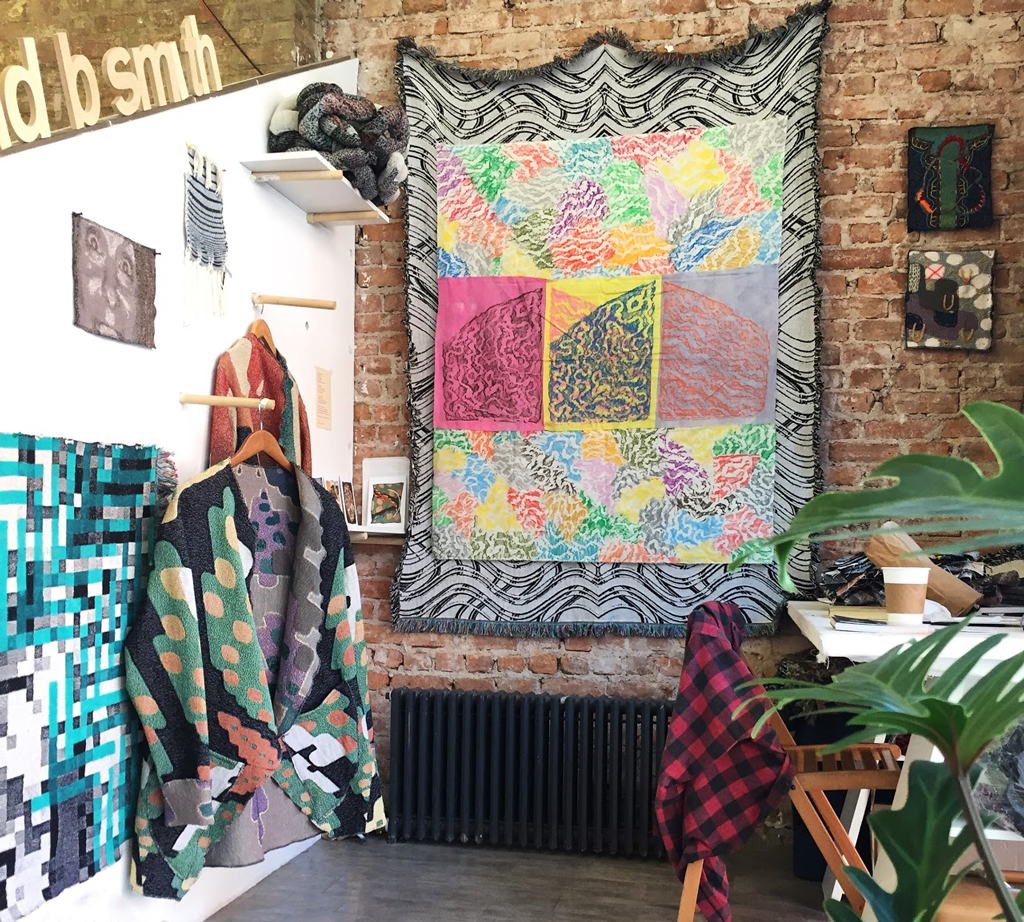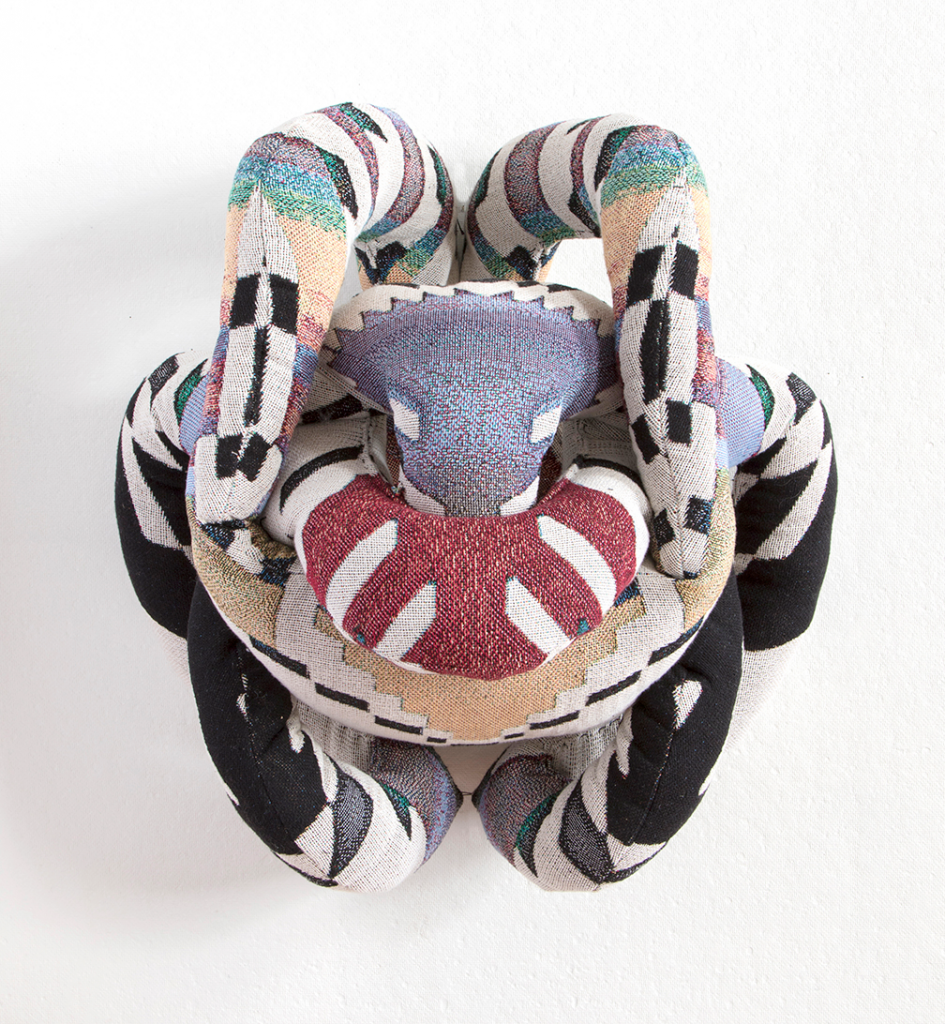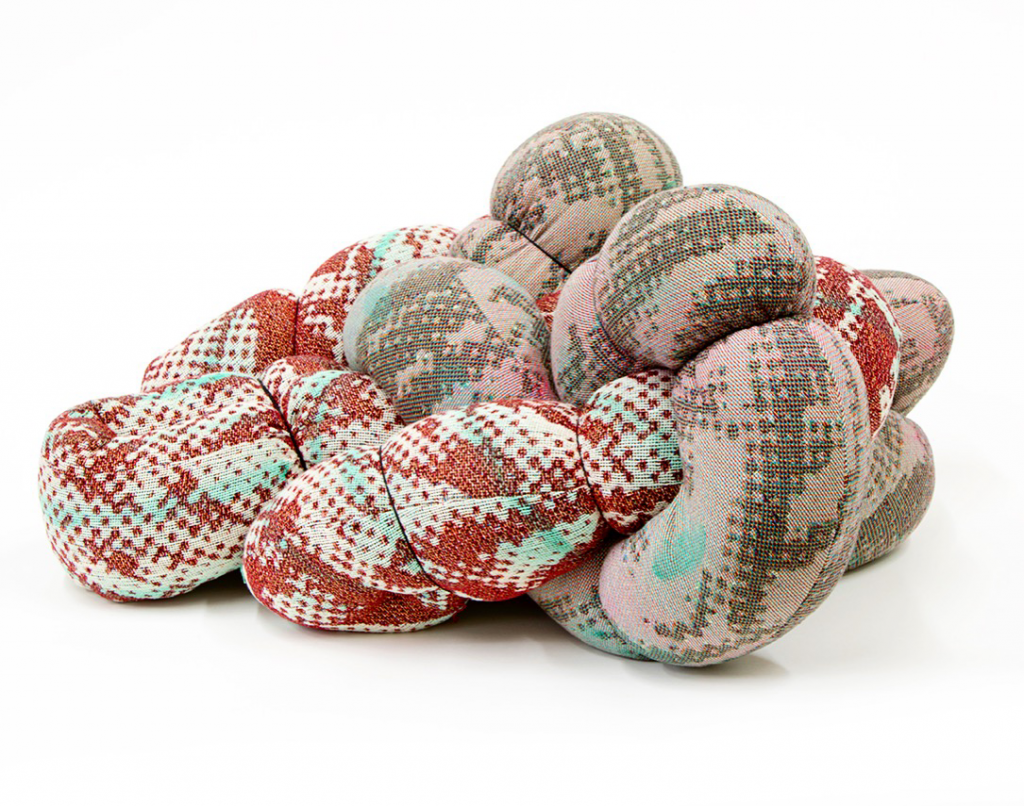WIP Artist Highlight: David B. Smith
I sat down with artist David B. Smith on a Saturday after his Open Studio hours. While the open chance to come in and speak to Smith had passed, he continued to observe how people passing on the street stopped to look in the window, interacting with his work in a completely different manner.
Smith came to textiles from photography, with an undergrad degree in art history from Oberlin College, and a graduate degree from the International Center of Photography and Bard College partnership. He made the move into textiles about five years ago, inspired by a photo-throw of a friend’s cat and her connection with the image. There is an accessibility to textiles, a comfort, and familiarity for the audience. This leads to higher engagement with the pieces, a breakdown of the boundaries that can be created by other mediums. He works in different forms, from large jacquard woven pieces to soft sculptures to wearables.
The idea of engagement and social engagement have led Smith to his project while a part of the Work in Progress residency. Titled “Mirror,” there is no specific outcome, only a specific idea. “It’s all about being present and considering all the input that I receive, and seeing what strikes a chord in me. How I can reflect it back most efficiently and that makes the most sense for my subjectivity and interest.” Smith is exploring new techniques and approaches to textiles, inspired by his interactions with others within the studio. Each artist has their own way to approach and explore textiles, and by understanding their approach, it offers an opportunity to try and think about textiles in a different way. This also breaks down to the idea of the artist as a solitary, inaccessible force. Viewers can see Smith’s process through the window and Open Studio, and how it can shift throughout the residency.
There were people within the studio hand weaving on looms, which sparked an interest for Smith. He quickly realized that he was not going to be able to reach the level of imagery that is within his work, instead wanting a digital intervention with the weaving. Space and tools can be limiting in the small 10 x 5 square foot studio, but Smith approached this challenge by exploring techniques he was already familiar with to create something unexpected. Instead of weaving, he is recreating the base pattern of a weave through paint on an existing grid, inspired by weaving pattern books within the studio. It is reflecting the reality of weaving but warped in execution and exact form. This continues Smith’s exploration in “Mirror,” it "reflects reality, but also warps reality.[...] What I take in will come out completely different, and I’m interested in emphasizing that difference. ”
There is a desire to take a very structured form, like jacquard weaving and then breaking down the structure through traditional hand techniques like embroidery. This intervention breaks down the rigidity of the weave, taking control and shifting the meaning for yourself. This ties back to an idea that Smith has about how by going back to these structured memories, or stories that we tell ourselves, we can slowly gain control over the ones that have control over us. Just like stitching or painting over a jacquard weave, we can gain control over these stories by repeated interventions. This leads to the idea of softness. Smith likes the soft, not just in structure, but “as a sign of strength and flexibility, and adaptation and movement. I’m being soft. I don’t know what I'm doing but that’s the point.”
Concepts of the mind, memory, and imagination are addressed in different ways and approaches. Currently, Smith is imagining an alternative future and scenarios where biological and technology has merged. Ideas of what our homes will look like, how we will communicate and how art will also change. While Smith has a range of inspiration, a lot comes from his own childhood in the 1980s, playing video games and adjusting from the pre- to post-internet age. During this period, there was a blending of organic and digital space. When Smith was playing Nintendo as a child he realized that he was inhabiting a character in a digital world, and he was holding it in his identity.
The embrace of imagination and memory of creating a beanbag in Cub Scouts led to Smith’s workshop “Make Your Own Pet Snake.” Open to all ages, it introduces participants to textiles and Smith’s work through making a small soft sculpture in the form of a snake. Smith uses tubular shapes in his work since it is a form found in biological formations from a root or branch to blood vessels. It is a workshop to explore your imagination and what creature you could create, whether of this world or a technological and biological future.
“Each artist has their own theories and they’re just saying their theories out loud. But for me, for example, I don’t expect people to adopt my theories, just to test it out, to see what works for you. [...] At the same time recently I’ve been having this idea of each artist having their own dream, like dreaming then so we’re all sharing our dreams with each other. [...] Our dreams are overlapping and I can learn from your dream, you can learn from my dream. And we can see how each of each other is thinking and what our hopes are, what our fears are. And to me, art is the greatest form of communication, the most nuanced form of communication to talk about really subtle things that are hard to talk about. ”



